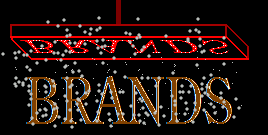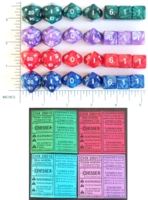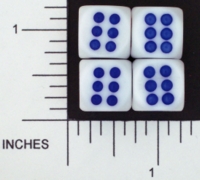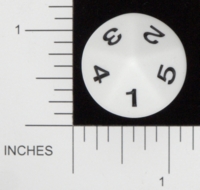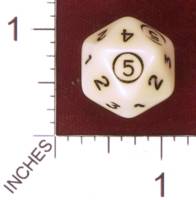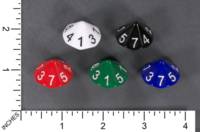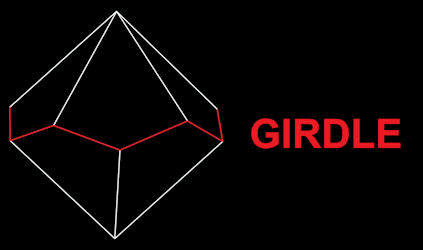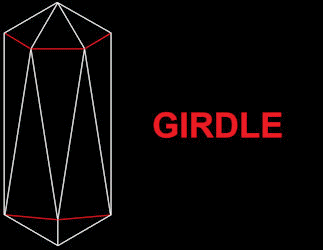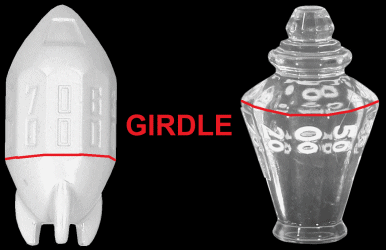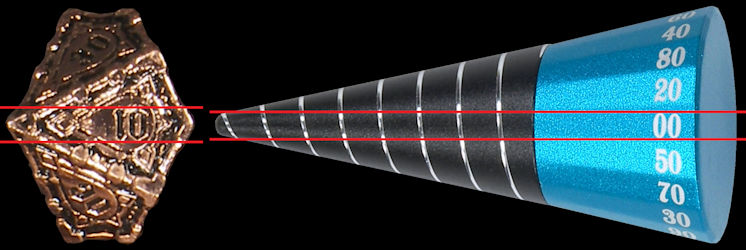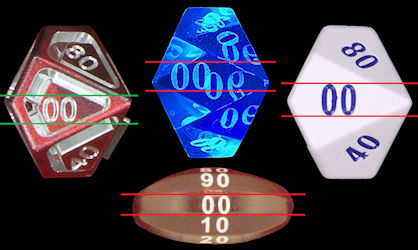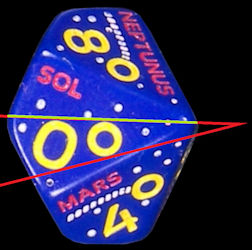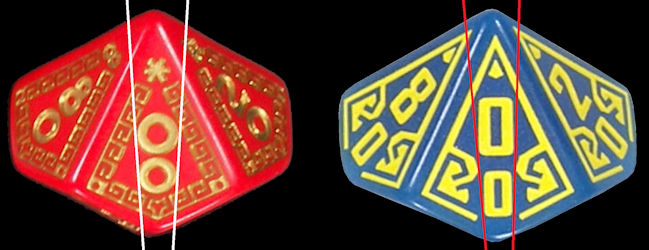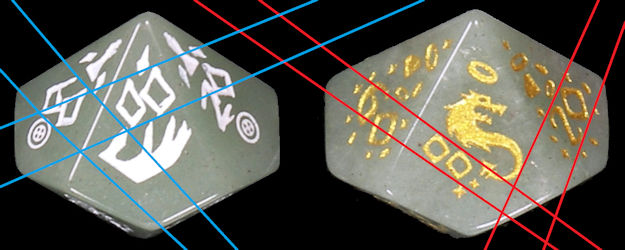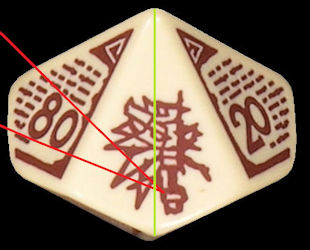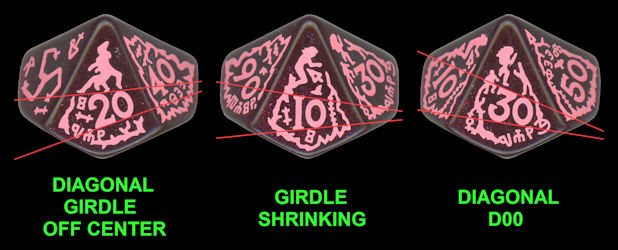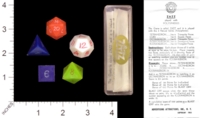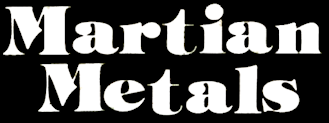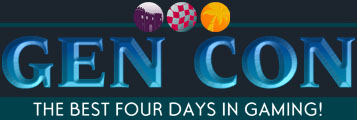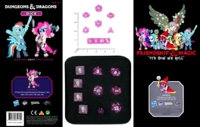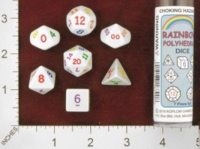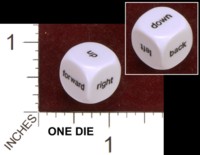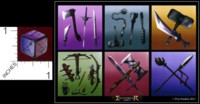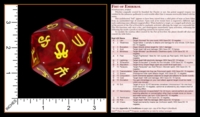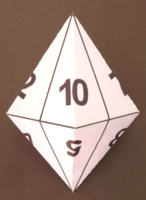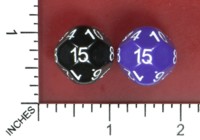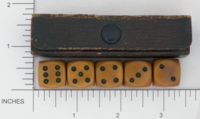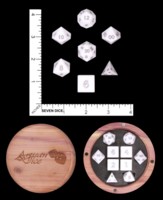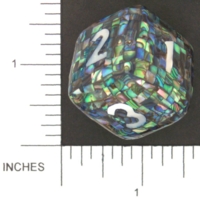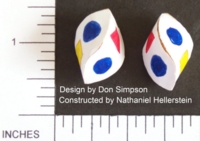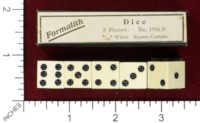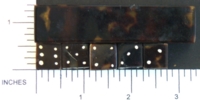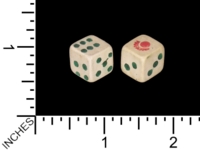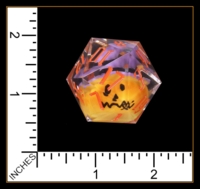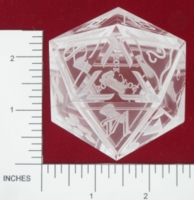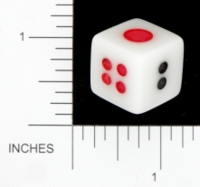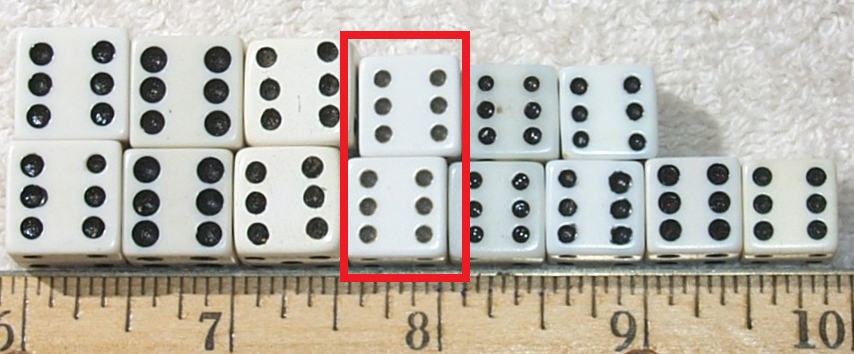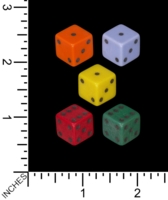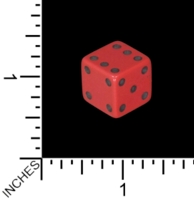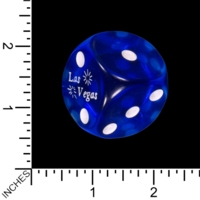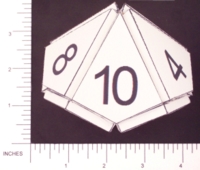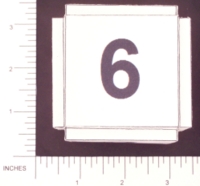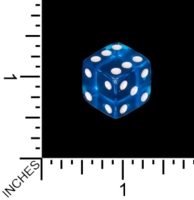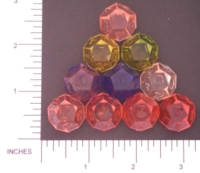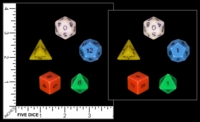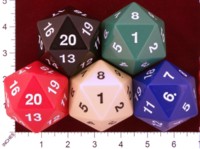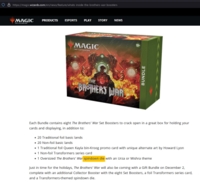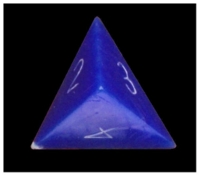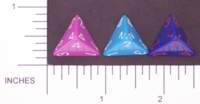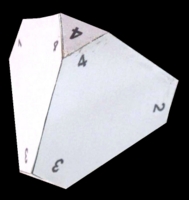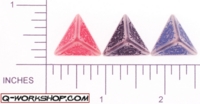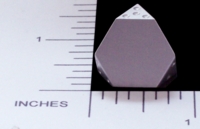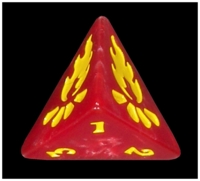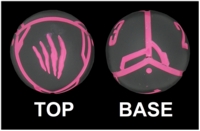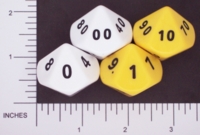 A list of terms ... definitions ... and ramblings related to dice and dice collecting |
| DATABASE COLUMN DESCRIPTIONS |
| BRAND |
COLOR |
COLOR STYLE | IN | INVENTORIED | LOCATION |
| MATERIAL | OPACITY |
SHARPNESS |
SIDES | SIZE | STYLE |
| TERMS AND SYMBOLS USED IN THE DATABASE |
| OTHER DISCUSSIONS ... THOUGHTS AND RAMBLINGS |
 ABBREVIATIONS
 |
| There are a number of abbreviations used by
members of Dice
Collecting
Groups D<NUMBER> - has its own section as this one is complicated FLGS - FRIENDLY LOCAL GAMING STORE ... usually a brick and mortar store like 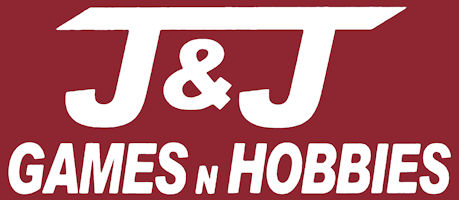 and and  ISO - IN SEARCH OF - Term used by someone looking for a die or dice MINT - A term that describes the condition of dice or the container in which they are stored as being in perfect condition When describing packaging it is often an abbreviation for MINT IN PACKAGE (MIP) or MINT IN BOX (MIB) NG / OG - NEW GLITTER / OLD (or ORIGINAL) GLITTER is a controversial issue and is discussed HERE OOP - OUT OF PRODUCTION - A product (dice in this case) that was made in the past and is no longer being made OOS - OUT OF STOCK - A product that was made in the past and is no longer in stock in stores ... It may or may not still be being produced POD - POUND OF DICE - Bulk dice are often sold by the pound  DICE
COMPANY ABBREVIATIONS
BOD - 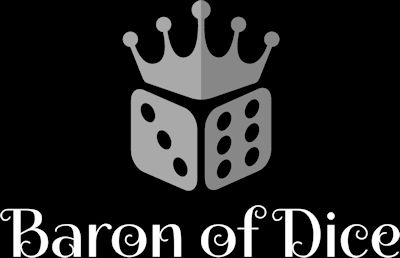 BOW - 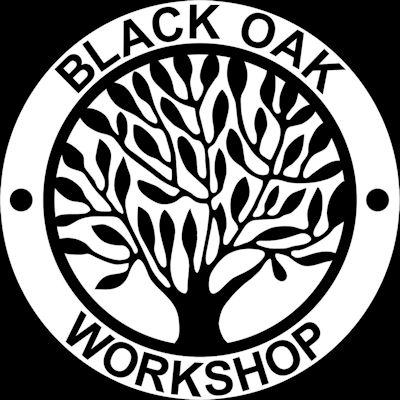 CC -  CHX - 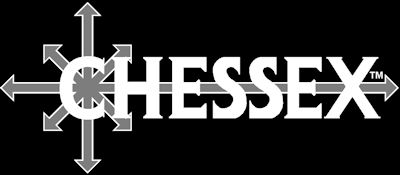 D&G - 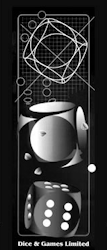 DICE & GAMES GW - 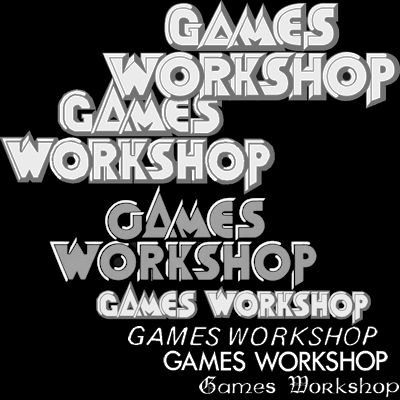 GS -  QW or Q-W -  SJG -  TSR - 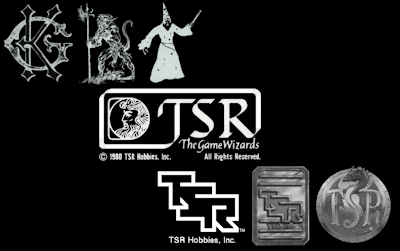 I think everyone knows this one ...
but few know it stands for Tactical
Studies
Rules I think everyone knows this one ...
but few know it stands for Tactical
Studies
RulesWOTC - 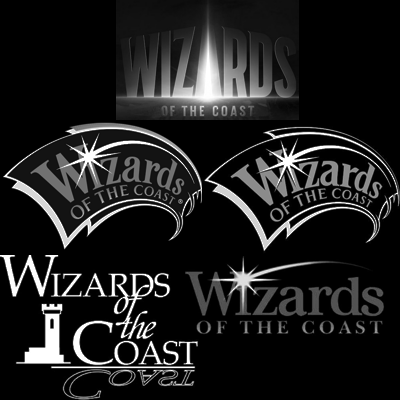 |
 BRAND (Database column & Dice Theme type)  |
| The BRAND (database column) of a
die is kind of a hard thing to define ... as such ... I try to
give as much info as I can in the database * First you have who sold it ... and they most likely are not the person or company who manufactured it  * Next you have who commissioned the die to be made ... which definitely is not who made it They can have several layers (yes ... like Ogres) of commissions If I know the next layer down ... I try to include it in the database as 'COMPANY NAME' CUSTOM It is common for a company who is known for selling dice ... such as 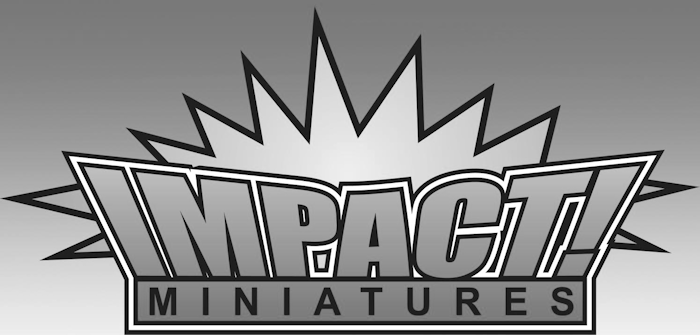 to commission dice to be made by to commission dice to be made by a company in China such as PANDA ... and they subcontract it out to another company EXAMPLE: This 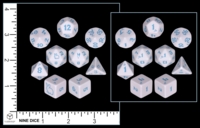 set was commissioned
by set was commissioned
by  but was made by but was made by  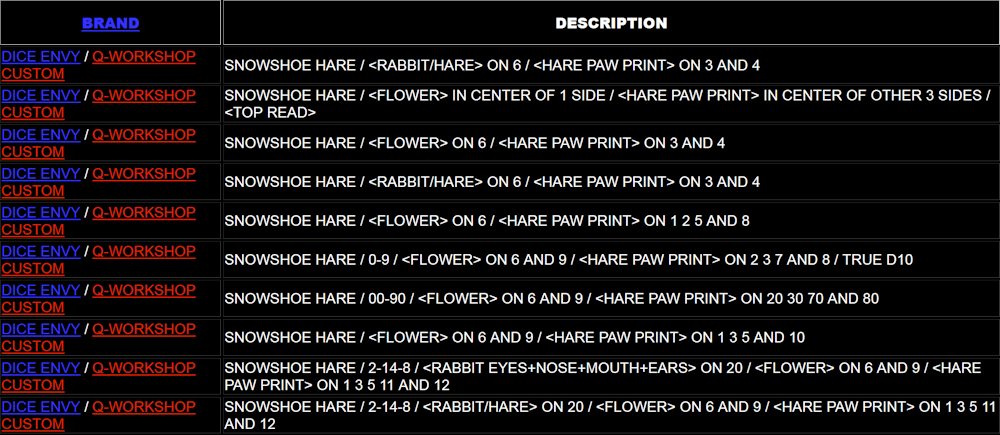 
* Finally you have the manufacturer ... the company or person who
actually made the die
Now that making your own dice is becoming common ... many end manufacturers are now direct sellers  |
 CHEATER ... GAFFED ... OR WEIGHTED DICE  |
| I suspect for as long as there have been
dice ... there have been players / rollers who try to cheat First ... I think we should define the opposite of the type of dice we will be discussing in this section Fair Dice ... are dice that roll an equal number of times on each side of the die ... Examples * A four-sided die (d4) that rolls each side 25% of the time * A six-sided die (d6) that rolls each side 16 2/3% of the time * A eight-sided die (d8) that rolls each side 12 1/2% of the time * A ten-sided die (d10) that rolls each side 10% of the time * A twenty-sided die (d20) that rolls each side 5% of the time Now ... let's discuss cheating One way of cheating is to develop a skill to roll a fair die such that a desired result is rolled ... This is sometimes called 'using English' ... blanket roll ... Greek shot ... slide shot ... twist shot or whip shot This page is devoted to Dice and Dice Collecting so I will not be discussing this skill While researching this section I became aware of a term of which I had not heard before PERCENTAGE DICE - Not to be confused with percentile dice ... this is a class of dice that include all dice that cause a specific side to roll upward a higher percentage of time than the other sides ... This includes Shapes ... Weighted dice This section will discuss dice that have been modified in order to cheat Over the centuries there have been many terms for dice of this nature ... Bevels ... Bricks .. Bristles ... Busters ... Cappers ... Cheaters ... Crooked ... Cut-Edged ... Flats ... Floppers ... Gaffed ... Loaded ... Missouts ... Passers ... Raised-Edge ... Sawtooth .. Shapes ... Shaved ... Slick ... Split-Edged ... Spot Loaded... Suction... Tappers ... Tops and Bottoms ... Trip... Weighted Generally crooked or gaffed dice have come to mean any die that has been physically modified to achieve a higher percentage of a desired roll 
There are seven categories of this type of die
1) BUSTERS ... CHEATERS .. DOUBLE NUMBER ... HIGH AND LOW ... HORSES ... MIS-SPOTTED .. TEES (T's) or TOPS AND BOTTOMS - are terms for fair dice that have been modified by removing certain values and adding others These are some of the terms for a fair six-sided (d6) that is manufactured with duplicate sides so that certain rolls can ... or cannot be achieved For example ... a pair of d6's with two 3's ... two 4's and two 5's ... can never roll a 2,3,4,7 or 12 (undesireable roll in the game of CRAPS after the point is set) HIGH or LOW - Dice that have two sides each of 4 ... 5 ... 6 ... or... 1... 2 ... 3 (respectively) are used to cheat in BACKGAMMON CHEATERS - A recent term that describes dice that have more than one high or low number ... for example a D20 with two 20's (opposing) or two 1's (opposing) Since opposing sides are the same value ... the correct value will of course be replaced by the high or low number opposing it 2) SHAPES - Is a generic term that describes a die
whose shape has been modified to rolll unfairly ...
for example ... a die with a convex side will land on that side less often than the non convex sides BEVELS - Dice that have been modified to have one or more convex sides BRICKS or FLATS - Dice that have been modified such that two opposing sides are larger than the others (brick shaped) so that the tendency is to roll one of the two sides more often SHAVED - A method by which a die is shaved or carved to roll unfairly SUCTION DICE - A die that has been modified to have a concave side to try to cause said side to slightly adhere to the rolling surface TRIP DICE - A die whose edges (razor / bevel (chamfer) / rounded (turned)) are modified in such a combination as to cause a higher percentage of desired rolls Specific variants of this type are: * CUT-EDGE dice which have one or more edges beveled at 45 degrees * RAISED-EDGE dice which have one or more edge that has a lip to influence the roll * SPLIT-EDGE or SAWTOOTH dice are dice that have a serrated edge to influence the roll 3) LOADED or WEIGHTED dice - A method by which a die is weighted to roll unfairly Good examples of this type of die will appear to be fair dice Cappers ... Floats (or Floaters) ... Floppers ... Spot Loaded... Tappers are just some of the terms used to describe the different methods of weighting a die These types of dice will appear to be fair even if measured with a micrometer ... but a weight has been added to cause the die to roll unfairly FLOATS or FLOATERS are dice that have a void space within the die to cause the side just above the void to be rolled more often They are referred to by these names as the dice tend to float in water SPOT LOADED - I could not find a description of this type of die ... but based on the tests to see if you have this type of die ... I assume that the pips (or spots) have been replaced / under-set ... with a heavy material such as lead, gold or platinum
TAPPERS or MERCURY TAPPERS
Dice which have a bead of mercury that can be channeled from the center of the die to a face or corner of a die to influence the roll
4) BRISTLES
A fair die that has been modified by adding a pin ... horse or pig bristle ... into a hole drilled into a center pip of a pipped six-sided die to cause the die to snag or catch on the rolled surface 5) SLICK A die that has some sides polished while other sides are roughened to cause certain values to be rolled 6) CAPPED Similar to shapes ... this type of die have had one or more sides shaved and the removed section replaced by a similar looking material that differs in in elasticity thus causing the die to bounce more when landing on the modified side 7) ELECTRIC or MAGNETIC A die which has had either the whole side or just the pips replaced by a ferro-magnetic material to allow an electromagnet to influence the roll This type of die as been used in CRAPS tables and CHUCK-A-LUCK cages 
Some generic terms with regard to this type of die
MISSOUTS are a pair of six-sided dice that favor 7's PASSERS are a pair of six-sided dice that favor passes (CRAPS term) and not 7's  I learned a lot when researching this section ... if nothing else ... I do not have many examples of this type of die ... and I now know names for the ones I do have REFERENCES : https://www.britannica.com/topic/tops-and-bottoms https://www.dice-play.com/DiceCrooked.htm |
 COLOR AND COLOR STYLE (Database columns)  |
| Die COLOR (database column) ... PIP COLOR (database column) and COLOR STYLES (database column) are discussed on HERE |
 CONVENTIONS  |
| At present there are no conventions specifically relating
to dice .... There are conventions that are very good 'hunting
grounds' for dice collectors There are many conventions that have their own dice ... this does not mean that they would be a good place to search for dice Of the conventions I have attended ... or spoke to people who have attended these are my choices of best places to attend to collect dice 1)  - Essen - Germany - Essen - Germany2)  - Indianapolis, Indiana - United
States - Indianapolis, Indiana - United
States3) 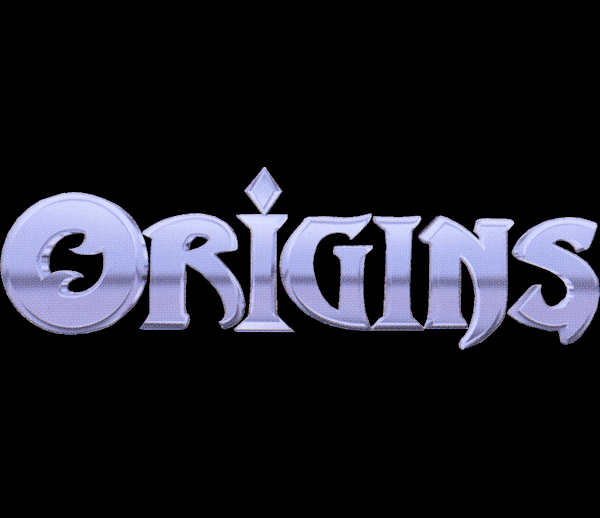 - Columbus, Ohio - United States
- Columbus, Ohio - United States4)  - United States (multiple locations) /
Melborne - Austrialia - United States (multiple locations) /
Melborne - Austrialia5) 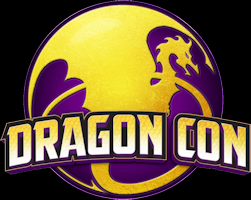 - Atlanta, Georgia - United States - Atlanta, Georgia - United States
|
 D<NUMBER>  |
| This term is well known by gamers (pen and paper) and dice
collectors ... but may not be known by others d or D followed by one or more characters (usually a number) is an abbreviation that most often describes the number of SIDES that the die can come to rest upon but not always EXAMPLES : D6 denotes a six-sided die 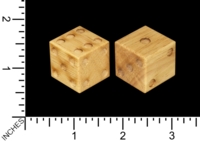 d20 is short for a twenty-sided die 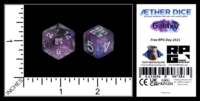 d100 (yes ... they do exist) are one hundred-sided dice 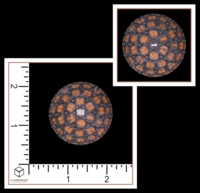  It can also represent the number of unique sides on a die as discussed HERE An exception to this rule is the deckaider ...D% .. D00 ... Tens (Chessex term) ... 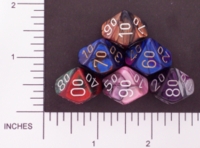 |
 D<NUMBER> VS <NUMBER>-SIDED  |
| I was having a discussion with a contributor when I
realized that a concept gamers take for granted may not be clear
to non-gamers Most non-gamers would not realize there is a difference between ... a D<NUMBER> (such as a D6) and a <NUMBER>-sided die (such as a six-sided die) Many games specify that if a D6 is to be rolled (for damage ... spaces to move etc) it is important to understand that this refers to a die producing a result of 1 through 6 (as opposed to backgammon doubling cubes, six-sided averaging dice, etc.) Dice collectors may use more vague definitions such as referring to any six-sided die as a D6 These two concepts (D<NUMBER> vs <NUMBER>-sided dice) ... are really FORM (number of sides) vs FUNCTION (number of unique degrees of freedom) ... so it is important to understand the difference  As stated in the section on D<NUMBER> ... It usually denotes the number of sides on a die ... There are a couple of small but important distinctions that need to be made ... 1) Dice with multiple and equal number of occurrences of each result ... For instance ... a six-sided die with two ones ... two twos ... and two threes is a D3 Examples: 2) Dice that are not sequentially numbered by one ... examples: * The deckaider / D% / D00 / Tens is a ten-sided die but not a D10 * Averaging dice which in the case of a D6 is numbered 2 ... 3 ... 3 ... 4 ... 4 ... 5 ... but this is not a D6 * Multi-Function Dice ... often have their own names ...  without regard to how many distinct indicia the die has ... so ... for the D3 example above ... it would be a six-sided die but it would be called a D3 Here are examples of dice with different numbers of sides:  So ... Think of D<NUMBER> as a die that rolls 1 to <NUMBER> and ... a <NUMBER>-sided die as a die that if you count the sides ... equal <NUMBER> *** NOTE: Many thanks to Arthur Storvik Levesque for his help on this section |
 <DESCRIPTION>  |
| <.....>
is a database indicator that denotes some sort of visual
description / attribute / feature Entries of this type are a visual descriptor enclosed by a Less Than (<) symbol followed by a Greater Than (>) symbol Examples include : <RABBIT/HARE> as seen above in BRAND this denotes a graphic <TOP READ> as seen above in DECKAIDER D% / D00 / TENS CONFIGURATIONS this denotes a configuration of the numbers on the die <MINE / SATELLITE SHAPED> ... this describes the shape of the die <ROUGH PEBBLED SURFACE> ... describes the surface of the die |
 DECKAIDER D% / D00 / TENS CONFIGURATIONS  |
The "Deckaider"
was first released in March 1990 by  It is the companion to the D10 which in combination is used for percentage (1-100) rolls ... and is numbered (and referred to in the database as) 00-90... where 00 either represents 100 when the d10 rolls a 0 ... or represents a 0 when 1-9 is rolled on the d10 This die has had a number of names over the years including ... Deckaider ... D% (Percentage Ten) ... D00 ... and Tens (Chessex term) The orientation and size of the numbers has also had a number of configurations over the years  This article will refer to this type of die by three characteristics The DIRECTION in which the numbers are read : * Across the GIRDLE * Towards the TIP * Towards the BASE * On a DIAGONAL The SIZE of the two digits relative to one another: * EVEN denotes that both digits are of the same size * SHRINKING denotes that the first digit (highest significance) is larger than the second digit The ORIENTATION of the digits on the die * OFF-CENTER indicates that the two digits are not centered within the boundary of the extension member facet ** NOTE ... if not otherwise stated the numbers are centered  This article will give examples of several SHAPES of this type of die
  These examples are in ascending chronological order of the date I first either became aware of ... or entered them into the database (usually soon after release) GIRDLE EVEN First mass-produced by :  Introduced : March 1990 Girdle Even was the first style of Deckaider This type of die is read parallel to the GIRDLE of the die ... and are the same size (EVEN) ... with the top of the number toward the tip EXAMPLES: Database entries 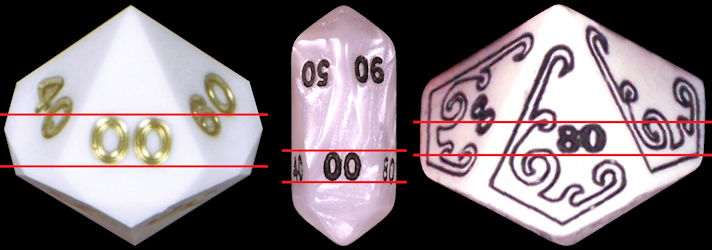 TIP SHRINKING First mass-produced by:  as far as I know as far as I knowIntroduced : Sometime after 1987 (founding of Chessex) but before 2000 (when I started recording my acquisitions) Tip Shrinking was the second style of Deckaider and likely was first introduced by Chessex This style of die is read perpendicular to the GIRDLE from the GIRDLE to the TIP with the second digit being smaller than the first (SHRINKING) EXAMPLES: Database entries  First mass-produced by :  Introduced : 2005 Girdle Shrinking is read parallel to the GIRDLE with the second digit being smaller than the first (SHRINKING) Database entries DIAGONAL D00 First mass-produced by :  Introduced : 2005 Diagonal is read diagonally to the central line and has numbers that are the same height Database entries BASE EVEN First mass-produced by : 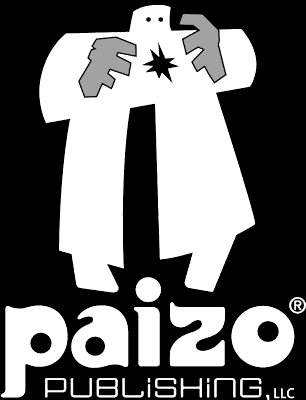 Introduced : 2015 Base Even is read from the TIP to the BASE and has numbers that are the same height Database entries DIAGONAL GIRDLE OFF-CENTER Never mass produced First Introduced by : Shapeways artist : Ceramic Wombat Introduced : 2015 Diagonal Girdle Off-Center is read off center diagonally to the central line from the GIRDLE (or BASE) to the TIP and has numbers that are the same height Database entries GIRDLE STACKED First mass-produced by : 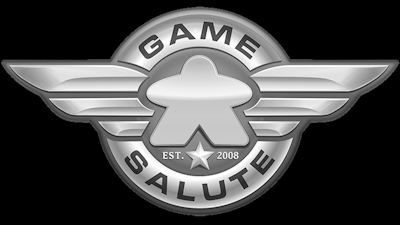 Introduced : 2016 Girdle Stacked is read around the GIRDLE but instead of the numbers being read horizontally ... The numbers (of equal size) are read vertically Database entries TIP EVEN First mass-produced by :  Introduced : 2016 Tip Even is similar to Base Even except the direction by which it is read from the GIRDLE (or BASE) to the tip and has numbers that are the same height Database entries DIAGONAL TIP SHRINKING OFF-CENTER First mass-produced by : 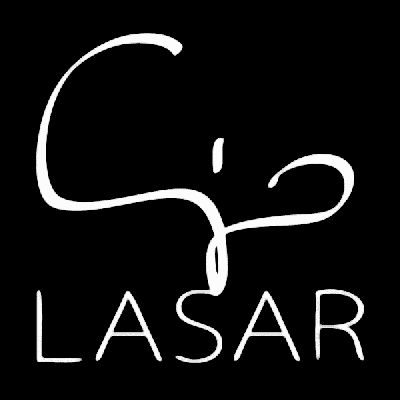 Introduced : 2017 Diagonal Tip Shrinking Off-Center is read off-center diagonally to the central line ... from the GIRDLE (or BASE) to the TIP with the second digit being smaller than the first (SHRINKING) Database entries GIRDLE STACKED SHRINKING First mass produced by : 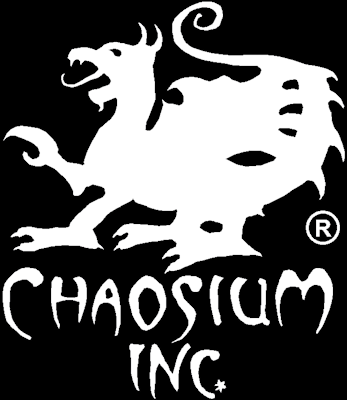 Introduced in : 2018 Girdle Stacked Shrinking is read parallel to the GIRDLE but instead of the numbers being read horizontally they are read verticaly ... The first/top digit is larger than the second/bottom digit (SHRINKING) Database entries COMBO D00 First mass produced by :  Introduced in : 2019 Combo or Combination Deckaider dice are read using two or more of the methods discussed here Database entries BASE SHRINKING First mass produced by : 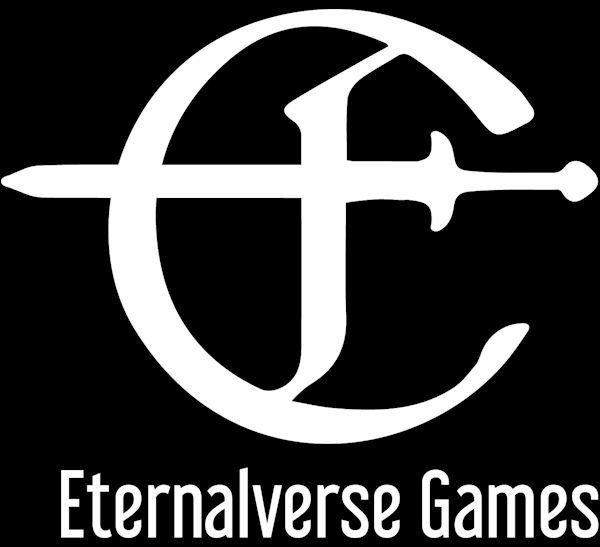 Introduced in : 2021 Base Shrinking is read perpendicular to the GIRDLE and read from the TIP to the BASE with the second digit being smaller than the first (SHRINKING) Database entries 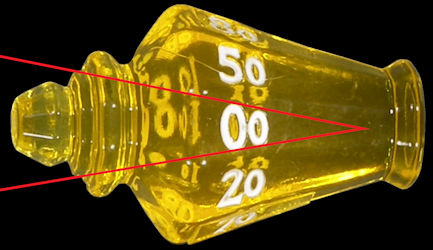 DIAGONAL SHRINKING First mass-produced by :  Introduced : 2022 Diagonal Shrinking is read diagonally to the central line from the GIRDLE (or BASE) to the TIP with the second digit being smaller than the first (SHRINKING) Database entries GIRDLE EVEN UPSIDE DOWN First mass produced by :  Introduced : 2023 This type of die is read parallel to the GIRDLE of the die ... and are the same size (EVEN) ... with the top of the number toward the girdle |
 DICE GROUPS (COLLECTING ... DISCUSSING and MAKING)  |
|
BUNBUN'S
BURROW
OF CLICK CLACKS! - Founded by Bonnie Higgins and Tiffany
Rose ... For the purpose of discussion of Dice CASINO CHIP & GAMING TOKEN COLLECTORS CLUB (CC>CC) seems to also be a contemporary with the DMC in April 1999 This group collects CASINO DICE as well as other casino paraphernalia COMMUNITY FOR DICE MAKERS OF ALL ABILITIES! - Another great group for the discussion of dice making ***DICE COLLECTORS - Dice Collectors was formed in 2016 by Christina Whitten A relaxed environment for dice collectors to talk and share anything dice related DICE MAKERS - Founded by Jaren Nielsen with Dice Fanatics ... For the discussion of dice making DICE MAKING AS A BUSINESS - Managed by Jared Nielsen with Dice Fanatics ... For the discussion of the dice making industry ***DICE MANIACS' CLUB (DMC) - The Dice Maniacs' Club aka The Random Fandom ... was formed in 1999 by Dr Alexander S. (wishes to remain anonymous) ... Dr Keng Ho Pwee ... and myself (Kevin Cook) ... It has had several meeting places ... let's call them clubhouses ... they include MSN groups ... Yahoo groups ... and the latest is Facebook Membership only requires that you have an interest in dice and or dice collecting ... and you call yourself a Maniac Think of the admins of the Facebook Group as the building management who put up with our nonsense ... keep the lights on ... and sweep up after our virtual meetings ... Many thanks ya'll There have been many DMC in person meetups over the years ... the most well attended at Spiel and Gen Con and others just passing by ***GOBLIN DICE HOARD (GDH) - Goblin Dice Hoard was founded in 2018 by Jennifer Roberts ... Melissa Alexandria ... and Alexandra B. They quickly became the largest virtual dice collecting group THE GREAT LIBRARY OF DICECRAFT - Formed by Kat Martinson and Tori Mayfield ... For the purpose of discussion of dice manufacturing OTHER LESS ACTIVE GROUPS DICE MAKING DISCOVERIES - Founded by Emily Schroeder and/or Carly Helliesen ... For discussion of dice manufacturing THE HISTORY OF DICE - Founded by Michael Schaffer ... For those who want to discuss the history of dice INTERNATIONAL BONE ROLLERS GUILD (IBRG) - Founded by Mitch Klink around November 2000 and existed until November 2007 The IBRG was a contemporary with the DMC but is now defunct and is talked about HERE MARVELOUS DICE RE-INKS - Founded by Shea Tahoe ... For those who who wish to discuss and display re-colored dice SPECKLED DICE COLLECTORS - Founded by Shea Tahoe ... For those who like to collect speckled dice |
 DICE-MAKING TERMS  |
| Most plastic dice are injection molded ... The major exception are CASINO DICE ... they are extruded into rods or sticks then milled as this is the method by which precision dice are made so they can meet the standards required by governments   Most metal dice use a different process ... but they still use molds Some metal dice use CNC milling ... 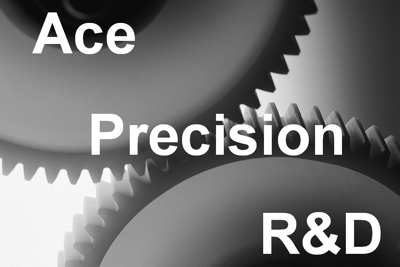 is a good example of this is a good example of this  This is a list of terms used by mass production injection molders: An EJECTION MARK is made when the molding machine uses a small rod or rods to force the die out of the mold 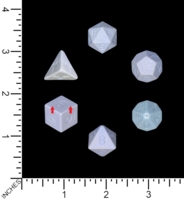  The GATE is the port through which molding material passes from the SPRUE to the MOLD 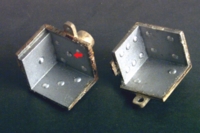  A MOLD ... sometimes referred to as a TOOL ... is a hollow device into which liquid molding material is injected to form a die 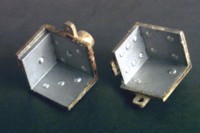  A PART LINE is happens when the two halves of a mold do not quite seal completely and the resulting die shows the line of the two halves 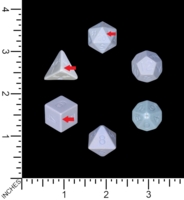  The SPRUE of a mold is the small channel through which the molding material is poured or forced They are often called 'trees' due to their branching appearance 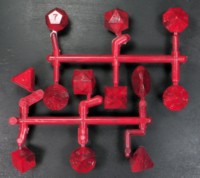 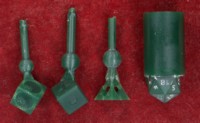  A SPRUE MARK or GATE MARK is left by the small channel through which the liquid plastic is poured into the mold 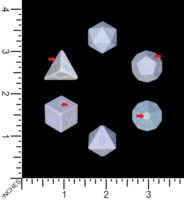  A die is TUMBLED ... much like rocks in a rock tumbler/polisher ... for two reasons * The RAW die is dipped in paint and allowed to dry ... the excess (paint not in the INDICIA) needs to be removed * The SHARPNESS of the die is wished to be ROUNDED This is a RAW die without paint / ink 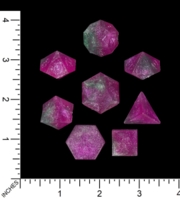 notice the sharp rough edges? notice the sharp rough edges? This is the same style of die that has been painted and TUMBLED  notice
the
edges are now smooth? notice
the
edges are now smooth? |
 DIE VS DICE  |
| DIE is the singular of DICE ... Common usage has caused 'dice' to mean both a single die or multiple dice |
 EARLY POLYHEDRAL DICE  |
| Excluding ANCIENT
or
ANTIQUE ... non-wargaming ...
and non-roleplaying polyhedral dice early polyhedral dice for games
like Dungeons
&
Dragons (prior to
 producing their own) producing their own) were made by companies like :
*** Most of these companies were only in business for a few years ... and all but one or maybe two as of now are out of business |
 EFFECTS (Dice Theme type)  |
 EXCLUSIVES  |
| EXCLUSIVES are dice that are / were only available for
initial sale at an event ... a specific time ... or for a specific
project (ex Kickstarter) It is quite likely that they will be available for re-sale but at an increased price EXAMPLES |
 EXTENSION MEMBER FACET  |
| EXTENSION MEMBER FACET is a term I learned while preparing
for the Michael Bowling (Crystal
Caste) v. Hasbro deposition It seems to be legalese for SIDE or FACE Although this term is not used in the database ... or even the website ... I felt that it needed to be defined |
 FACES VS SIDES  |
| The Database uses
the
terms Face(s) and Side(s)
interchangeably In most cases SIDE is used to indicate the extension member facet Face(s) most often refers to the front part of a person or creature's head |
 FONTS  |
| FONTS are the style in which numbers or
letters are made (printed ... molded etc) ... this page for
example ... uses the ARIAL font Over the years dice dice have used many styles of fonts ... some already known ... others made up by the manufacturer or mold maker The font used on dice often can help identify the BRAND Here are some examples 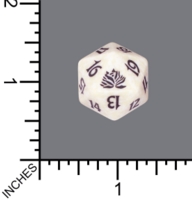 This
font was created exclusively for This
font was created exclusively for  and has been copied many times and has been copied many times These are common fonts ...
notice how this die uses at least 3 different fonts? ... Look at
the '0's These are common fonts ...
notice how this die uses at least 3 different fonts? ... Look at
the '0's 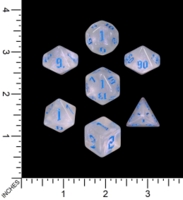 This is one of my favorite
fonts used on dice ... I call it FANTASY ... as it reminds me of
the font from Harry
Potter This is one of my favorite
fonts used on dice ... I call it FANTASY ... as it reminds me of
the font from Harry
Potter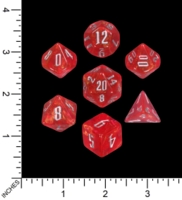 Here is another font from the same manufacturer that I call
GOTHIC
Here is another font from the same manufacturer that I call
GOTHIC Fonts are another passion of mine as you can see with some of the themes on the site  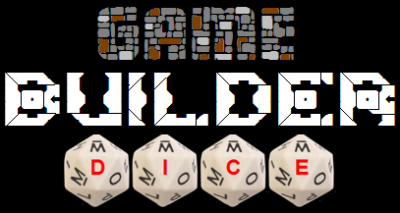  |
 FREQUENTLY ASKED QUESTIONS  |
| This is a list of the questions I am most asked about Dice
... Dice Collecting ... and the Collection ** Do you have a favorite die or set of dice? No .. as the collection is constantly changing ... the first die that comes to mind ... also changes ** How long have you been collecting dice? Short answer ... since August 1977 ... LONG ANSWER ** How many dice do you have in the collection? The best way to tell is look at the number at the upper left of the main page for the site ** Do you really have the Guinness Record for the Worlds Largest Collection of Dice? Yes ** What is the smallest / largest die in the collection? CLICK HERE ** How to you know if you have a die / how do you prevent duplicates? I have a database that I search and use the method HERE to try to prevent duplicates ** Do you ever get tired of collecting? No ... I suppose it could be considered an obsession and I always manage to find new and interesting dice to add ** How do you recommend that a new collector get started on a dice collection? Start small ... Don't try to take on everything ... Pick a niche ... Blue dice ...or Warhammer dice ... or Brass Dice ... for example ... Set a spending limit and stick to it |
 HOW IS THE COLLECTION STORED?  |
| The collection has been stored in several ways over
the years ... It first was stored in a large velour bag made from an old shirt ... when filled it looked like a faded orange bowling ball bag Next ... I made a wooden chest that had an old brass railroad lock ... and had wooden trays to hold the dice ... I would take it to conventions and carry it around on my shoulder like a pirate .... Don't all good stories involve a pirate? When next it expanded ... I added a green wooden chest from some place like Pier1 Imports I never tried carrying both chests around ... there was too much of a chance for disaster As the collection grew ... I had to use Tupperware containers of increasing size and shelf units HERE are some photos of the collection as it exceeded the wooden chests |
 HOW MUCH IS <THIS> WORTH?  |
| I am often asked this question and it depends on a
lot of factors such as ... AGE - the older a die is ... will affect the price for which it will sell ... sometimes it increases the value ... sometimes it decreases the value RARITY and DEMAND - These two factors go hand in hand If something is rare does not necessarily make it valuable ... For example ... a hand made die If it is in high demand but is not rare it can increase the value ... such as dice from collectible dice games MATERIAL - It should be obvious that if the raw materials from which a die is made costs more than some other material ... then the price SHOULD be higher in order to defray the cost of goods produced CONDITION - This one should also be obvious ... It seems logical that if a die or dice are in MINT condition they would be worth more than those that are in a less-than perfect condition However ... There are collectors out there who collect worn or damaged dice NONE of this answers the question ... but provides background The true answer to the question is ... a die or set of dice are worth what the market is willing to pay Often this can defy all of the conditions mentioned above ... I have seen plain .. not very attractive dice sell for hundreds of dollars ... I have seen very attractive dice (to me) sell for a small amount This still does not answer the question ... perhaps a better question would be "How much does <THIS> sell for now? " The best way I can advise for this question is to check sales history on ebay since it reaches the most people HOW TO CHECK PAST SALES ON EBAY 1) Go to ebay.com 2) In the upper right next to the SEARCH button click on ADVANCED 3) Fill in the keywords for die or dice that you are wishing to value 4) Check the radio button SOLD LISTINGS ... Do not check Completed Listings as this includes auctions that do not sell .. and are often overpriced 5) Click Search 7) Come back regularly and do the search again until you have an idea of what people are willing to pay for your dice :) |
 HOW TO IDENTIFY DICE  |
| Dice can be identified by several means ... * By the FONT if it is unique to the die or BRAND  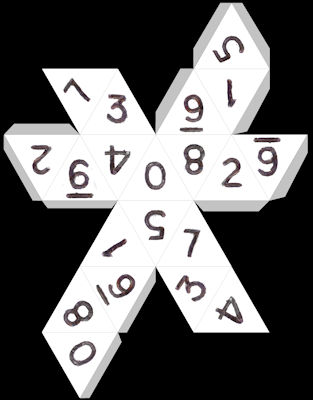 I have accumulated a number of these to assist in tellling  This method has been my most successful over the years as nearly every company's mold is different ... so the orientation of the faces with regard to the faces touching them will identify a mold ... which usually identifies a manufacturer  An example can be seen HERE Here are other databases that can be used for such a search : Dice DB ALEA KYBOS' DICE COLLECTION   have have ... small G's on the 1 side of their D20 ... D16 ... D14 ...D6's and D4's 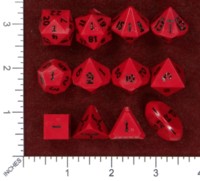 ...  and other info in between
the numbers of their D100's and other info in between
the numbers of their D100's 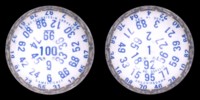  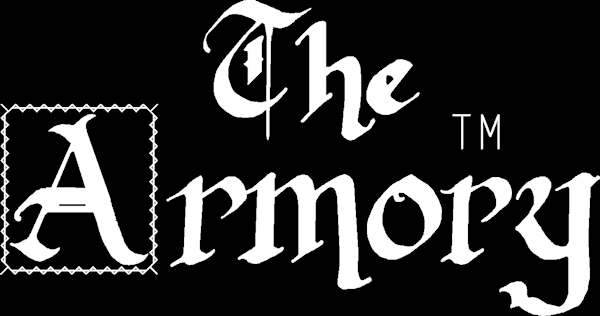 first generation have A's ... first generation have A's ... ... on one of the two 0 sides of their d20's  ... on the 1 side of their D8's  ... on one of the 1's on their D4's  |
 IN (Database column)  |
| IN (database column) is an abbreviation
that indicates if the dice are contained within a container inside
the LOCATION
container EXAMPLES: A - CLAMSHELL 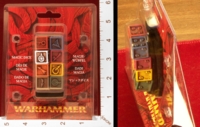 is usually a single part
molded plastic container that encloses the dice is usually a single part
molded plastic container that encloses the dice B - BOX 
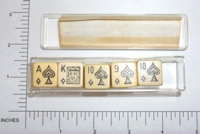 usually cardboard or plastic usually cardboard or plastic C - CARD 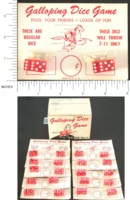 differs from BLISTER PACK in
that the dice are affixed to the card rather than contained
within plastic differs from BLISTER PACK in
that the dice are affixed to the card rather than contained
within plastic F - FOIL PACK  are
usually
also found in boxes are
usually
also found in boxes 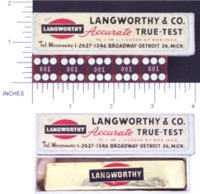 ... but not always
... but not always G - BAG 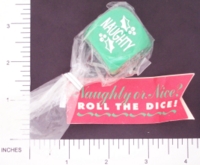 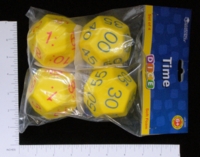 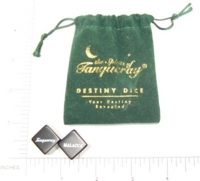 H - HANG TAG 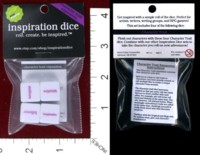 differs from CARD
and BLISTER pack in that it is a BAG hanging from a CARD differs from CARD
and BLISTER pack in that it is a BAG hanging from a CARDI - TIN  L - LEATHER BOX 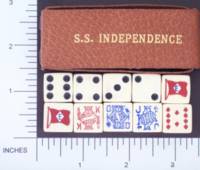 N - CAN 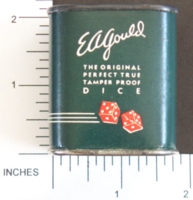 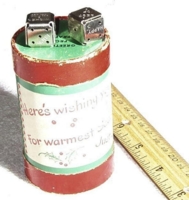 O - OTHER   P - BLISTER PACK  is usually a
heat or glue bonded plastic container bound to a card that
contains the dice is usually a
heat or glue bonded plastic container bound to a card that
contains the dice T - TUBE 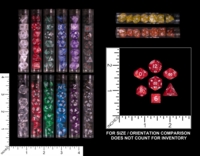 |
 INDICIA  |
| INDICIA ...
as it pertains to dice ... is another term I learned while
preparing for the Michael Bowling (Crystal
Caste) v. Hasbro deposition Indicia is not often used in the database or website but I thought it should be included here An indicia is a mark on a die that shows a result of the die being rolled Here are some examples of forms of indicia :
The result of the roll is usually the topmost indicium (singular of indicia) on a face ... but not always ... as in 'old school' four-sided dice (d4) Notice how the number rolled is the bottommost number? 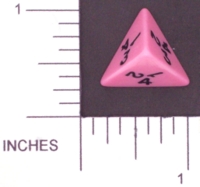 Another example where the number
is topmost ... but is on an edge ... not on a face ... is the
first image below
I came up with this design in 2003 and may have been the first to do so ... I call them Straight Edge dice ... after the Punk Subculture A couple of manufacturers have also used this idea ... but not on sharp edged dice ... second image | ||||||||||||||||||||
 INVENTORIED (Database column)  |
| When the database
was first created this column was intended to mean when a
particular die was entered into inventory This usually meant close to when they were first available ... At certain times it has been necessary to re-inventory certain dice ... and the date was then changed from the original date to the current |
 LOCATION (Database column)  |
| LOCATION
is an identifier that allows me to locate a
container containing a die within the collection It is usually a Tupperware ... Rubbermaid ... or Sterilite container of various sizes but sometimes are LOOSE I have been asked about the term MINT which is the prefix to most of the container names. It is just a word I chose to use early on in the collection I started with MINT1 and have continued using the prefix ever since (at the time of writing ... I am on MINT87) There is one exception for this column ... PLACE HOLDER |
 MATERIAL (Database column & Dice Theme type)  |
| Over the past 5 millennia ... dice have been made of a lot
of materials ... I have missed some (on purpose) MATERIAL(database column) describes what the outside of the die is made of ... the interior may or may not be of the same material For example ... Cloth dice with some sort of filler ...it could be cotton ... foam ... beans ... or even shredded paper Here are the types of material and their abbreviations that I use in the database : ** NOTE : If the material type shows a link ... this is a link to a page that I have devoted to that material type   Sometimes called knucklebones ... these were a very early version of dice C - CELLULOID or Parkesine or Xylonite or French Ivory is an early (1856) plastic like material that was used as a replacement for Ivory Celluloid dice are often identifiable by their layered appearance  I keep my candy dice refrigerated to prevent degradation as much as possible  HERE are some templates if you wish to try to make your own  I have seen videos of a gaming group having a battle using foam dice    An exception to the ban is ivory harvested from animals who live / lived in captivity ... and even then ... you must have special permits to manufacture using this material  Dice can be made from soap either by carving ... or molding K - BAKELITE dice are made using the first synthetic plastic which originated in 1909 Bakelite has an odd smell when rubbed or placed in hot water and when cleaned with Simichrome Polish ... 409 ... gives off a yellow or brownish residue on the cleaning cloth / swab  M - METAL is a common material from which dice are made So far I have acquired dice made from : Aluminum ... Brass ... Bronze ... Copper ... Gold ... Iron ... Lead ... Magnesium ... Nickel ... Palladium ... Pewter ... Rhodium ... Ruthenium ... Silver ... Steel ... Titanium ... Tungsten ... White Metal ... Zamak ... Zinc and Zirconium  O - OTHER is the category that I use for dice that are made of unusual or rare material
 P - PLASTIC dice almost do not need any explanation The two most common plastics used for dice today are Acrylic and Resin There are two types of plastics from which dice are usually made ... thermoset and thermoplastic. Plastics are strands of polymer chains. * Thermoplastics are the more common plastic used today. They are are made using pellets that are heated then injected into molds of a desired shape. Thermoplastics have the same polymer chains in both solid and liquid (melted) form. Acrylic is a thermoplastic * Thermoset plastics only have polymer chains in solid form. This type of plastic canít be melted and used for something else Thermoset resin uses two chemicals and when mixed together a chemical reaction occurs that generates heat and causes the polymer to conform to the shape of the container. The most common resin that is used for dice is epoxy   The earliest set seems to be from 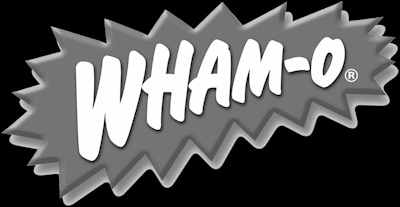 from 1966 ... and were remade in
2013 from 1966 ... and were remade in
2013  These 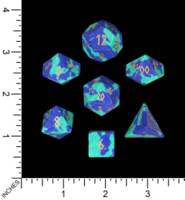 are a mixture of
stone and plastic as are most if not all dice in this category are a mixture of
stone and plastic as are most if not all dice in this category U - UNIDENTIFIED means I am unable to determine of what material the dice are made  The most known of the modern polymer clay brands are FIMO and SCULPY    Once hardened ... they become quite durable Z - COMPOSITE dice are those dice that are made up two or more distinct materials For instance ... These  are made of plastic and metal
are made of plastic and metal These  are paper on the inside and plastic on the outside
are paper on the inside and plastic on the outside This 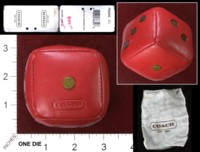 die is leather outside and seems
to be lead shot on the inside die is leather outside and seems
to be lead shot on the inside |
 N+1 RULE  |
| The N+1 Rule describes the total of the values of
opposing sides of sequential numbered dice where N represents the
number of SIDES I am not sure who came up with this rule ... but I observed it early in my collecting with observations of pipped six-sided dice I noted that most d6's in the collection had 6 and 1 ... on opposite sides of the die ... 5 and 2 ... and 4 and 3 if totaled ... this came to 7 ... and since this is a six-sided die (N) ... it is N+1 This rule holds for most polyhedral dice ... with notable exceptions : * 20-sided dice numbered 0-9 twice For this type of die it is normal for sides of the same value to oppose each other ... so 1 opposite 1 ... 2 opposite 2 ... etc * Most PENTAGONAL TRAPEZOHEDRAL shaped ten-sided dice 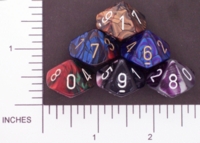
I believe that this started with the first true ten-sided die released in 1980 by  This type of die usually has 1 opposite 9 (or 10 opposite 90 for a deckaider) ... My thoughts as to why this happened are ... it was thought that the highest number on this type of D10 was 9 ... with 0 being the lowest ... in actuality when rolled as a D10 (as opposed to PERCENTILE DICE) 0 represents 10 So to follow the N+1 Rule ... such a die should have 1 opposite of 0 (10) ... 2 opposite 9 ... etc  Modern thought about this rule seems to trend toward dice that follow the n+1 rule being more fair than those that do not If one discounts that a die may be imbalanced or that the roller is actively trying to cheat (use "English") ... layout of the numbers on such a die becomes irrelevant For example If we have two different ... balanced ... dice that were made such that the numbers cannot be seen using normal light (must use ultraviolet light) ... The Level Up Stealth and Stealth II dice are examples of this One die follows N+1 ... the other does not follow N+1 Since the dice are both balanced ... and the factor of the roller being unable to see the numbers and use 'English' to influence the roll ... then configuration of the numbers on the dice should have no influence on what is being rolled TIP: If you feel that someone is cheating ... and that their dice are not gaffed ... insist that they use a rolling device such as a dice cup or dice tower |
 OPACITY (Database column)  |
| OPACITY
(database column)
describes the ability of light to pass through a die Here are the types of opacitance and their abbreviations that I use in the database :  This is for those types of dice that have sections that are clear ... and sections that are opaque  This should be self explanatory but it seems some dice manufacturers confuse Translucent with Clear Clear dice are translucent ... but not all translucent dice are clear Clear ... by my definition means ... you can see objects behind the die ... through the die O - OPAQUE Opaque dice are those where light is not able to pass through the body of the die T - TRANSLUCENT Translucent dice are those dice where light can pass through ... but you are unable to see through the die The most common of this type of die is frosted casino dice |
 ORIENTAL 2 (Database term)  |
| A type of pipped
six-sided
die (d6) exists in countries like China ... Japan ... and Taiwan
where the one (1) pip
is enlarged) and is red and sometimes the four pips are also red ... in addition the two side is vertical/horizontal (side to side) as opposed to the diagonal (from corner to corner) style of non eastern dice |
 PARCHISI (Database term)  |
| I was first introduced to the game Parchisi
or
Pachisi in the late 1960's or early 1970's At that time ... inexpensive dice were included in the game and had flat black ... round bottom pips |
 RECOLOR  |
| RECOLOR or Re-ink or even Color or Ink is not to be
confused COLOR
of the body of a die or its INDICIA In this case ... this is an action taken by someone * In some cases ... the INDICIA of dice are uncolored (uninked) and the owner decides to embellish the die by using ink or paint * In other cases ... the original coloring has degraded or is hard to read so the owner recolors the INDICIA * In still other cases the owner may find the die to be dull or uninspiring so the INDICIA is changed by re-painting or reinking HERE ... I discuss the process by which I remove existing color in INDICIA and then replace it with other colors |
 SHARPNESS (Database column)  |
| SHARPNESS
(database column)
is an abbreviation for the description of the edges of a die B - BEVELED EDGES Also called chamfer ... a beveled edge die is a die that has a flat surface for an edge that is not perpendicular to any of the faces. This type of die has a small chance of landing and standing on one of the beveled edges C - CORNERS (ROUNDED) The edges of this die are sometimes called Ball Corner This type of die has the characteristic of having rounded corners ... and in the case of a six-sided die ... has a circular face I - IRREGULAR Irregular dice follow a general line like sharp edged dice but are irregular or uneven L - SLAB FACE I designed these in August 2005 and do not think anyone has made a production version I call them slab face as I imagined a die made of slabs of concrete ... either square ... triangular ... or deltahedral O - OTHER Dice with this type of edge do not fit any other classification ...There are not many of these R - ROUNDED (EDGES) Dice with this type of edge are rounded ... similar to the rounded corner style ... it is rounded all the way to the corner (vertex) of the side S - SHARP Dice with this classification of edge are sharp ... but not so sharp as to be able to cut ... that type of die is classified as RAZOR X - INDESCRIBABLE Well ... uh Z - RAZOR This classfication of edge is also SHARP ... but is so much so that they can cut things like paper Casino Dice are ... as far as I know ... all razor edged unless they have degraded so much as to no longer be sharp 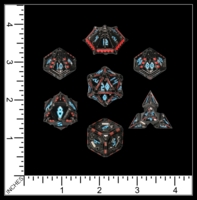  |
 SHIPPING TIPS (HOW TO SHIP DICE?)  |
Here are my suggestions for shipping
dice 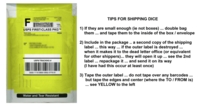 |
 SHOPPING TIPS (WHERE TO BUY DICE?)  |
| Here are the sources I have used over the years for
acquiring dice ... This list is in order of what I believe to be QUANTITY of dice acquired 1) eBay - I have no easy way to determine accurately how many dice have been acquired via eBay ... If feedback is an indicator ... mine is around 4250 unique sellers 2) Word of mouth - I hear from manufacturers ... vendors ... and more importantly fellow collectors ... either via email or via social media 3) Crowd funding sites like Kickstarter and Indiegogo 4) Conventions are great resources for meeting dice company representatives and fellow collectors 5) Online shopping centers - eBay qualifies for this category but as it has been the largest source over the years it has its own classification ... Amazon ... Aliexpress ... Etsy are the main 'online shopping centers' as they sell items other than dice ... as well as dice 6) Direct sales via a manufacturer / vendor website This is part of #2 above but not completely as there are sites I visit regularly and discover new styles of dice without being notified 7) In person purchases - including my FLGS and CONVENTIONS 8) Trades with fellow collectors 9) Donations - Over the years ... donations have come from * My FLGS (Thanks J&J's and Relentless Dragon) * Fellow collectors (Thanks Chris ... Ericka ... Joe and Yorkus) * Gamers (who do not specifically collect) * Manufacturers / Vendors often include extra dice in my orders (Thanks Q-Workshop and Udixidice) |
 SIDES (Database column)  |
| SIDES
(database column) is similar
to
D<NUMBER>
except that it always represents the number of physical
sides Click HERE to see the sides summary of the collection If a die has consecutive numbering from 1 to the number of sides ... then SIDES and D<NUMBER> would be the same number If the die has consecutive numbering from 1 to N where N is a divisor of SIDES and has this series the divisor number of times SIDES and D<NUMBER> would NOT be the same number EXAMPLES This set  is
numbered 1 to 4 two times ... so the number of sides is 8 but it
is a D4 is
numbered 1 to 4 two times ... so the number of sides is 8 but it
is a D4It is represented in the database as 1-4 (X2)  These dice  are numbered 1 to 4 three times
... and are twelve-sided but is also a D4 are numbered 1 to 4 three times
... and are twelve-sided but is also a D4 It is represented in the database as 1-4 (X3)  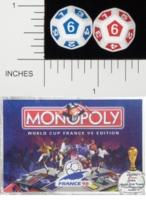 are
numbered 1 to 6 twice ... are twelve-sided ... but are a D6s are
numbered 1 to 6 twice ... are twelve-sided ... but are a D6s It is represented in the database as 1-6 (x2) Finally ... the most common die of this type ... at least for pen and paper gamers This die 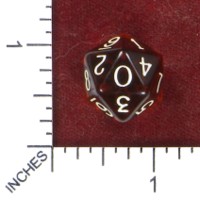 is numbered 0 to 9 twice ...
even though this is twenty-sided ... it is technically a D10 is numbered 0 to 9 twice ...
even though this is twenty-sided ... it is technically a D10If one of each number is colored a different color from the first set ... this die could be used as both a D10 and a D20 EXAMPLE : If one set of 0-9 was red and the other white ... the roller would say RED HIGH to indicate which were the numbers 11-20 ... so a Red 0 ... would usually be the ultimate goal .. a 20 :) It is represented in the database as 0-9 (x2) |
 SIZE (Database column)  |
| If you are seeking information about the Smallest
and
Largest dice in the collection ... CLICK
HERE SIZE (database column) is kind of a nebulous term in the database as I chose to only give a quantitative measurement for cubic six-sided dice When measuring cubic six-sided dice ... the numeric measurement is in INCHES and is from one face to the opposing face Click HERE to see the sides summary of six-sided dice in the collection Definition of non cubic six sided dice requires a bit of history ... In the mid 1970's  and later and later  released dice that seem to have used similar molds Here is an example of the TSR (Holmes) version In this set ... the D20 and D12 are larger than the 'standard' that is discussed below ... and the proportions of these dice never seems to have become standard A bit later in the mid 1970's  released their
polyhedral sets released their
polyhedral sets These dice seem to have now become the 'standard' propotions for polyhedral dice As I could not establish a method of consistent measurement ... face to face ... corner to corner ... etc ... mostly due to things like the D7 ... I refer to general terms in relation to the sizes of the aforementioned Gamescience dice which I will refer to as STANDARD When polyhedral dice are identified with a size (12mm ... 16mm ... 20mm ... 30mm ... 55mm) ... this typically is a measurment from face to face In poly sets ... it is usually the measurement of the d6 from face to face Here are my terms : TINY <75% the size of standard MINI 75% the size of standard ... This size of polyhedral dice set is sometimes called 12mm SMALLER 76% - 90% ... This size of polyhedral dice set is sometimes called 14mm - Designated by a dash (-) this is the most common size ... either due to the dice being consistent with the STANDARD size mentioned above or because there is no standard for the shape This size of polyhedral dice set is sometimes called 16mm LARGER 150%-200% the size of standard ... This size of polyhedral dice set is sometimes called 20mm LARGE 201%-500% the size of standard JUMBO 501%-1000% the size of standard HUGE GREATER than 1000% the size of standard I apologize for not being more precise ... One consolation is ... for most dice ... I include a ruler or reference die in the photo with the die / dice |
 SPINDOWN (Database term)  |
|
Spindown (or Countdown) is a term used to describe the
layout of the numbers on a die The term is used by games like MAGIC THE GATHERING as the 'die' (I will discuss this later) is used as a countdown marker for the player's life points It can be recognized by the die being numbered sequentially from the highest number to the lowest number with each number adjacent to the next lowest number This allows the player ... with one turn of a face of the die ... to adjust upward or downward the statistic they wish to modify This type of die sometimes follows the N+1 rule but other examples do not Most examples of this type of die are twenty-sided (d20) ... but there are ten-sided (d10) ... thirty-sided (d30) and forty-sided (d40) examples  For several years there has been a discussion (sometimes heated) as to whether spindowns should be considered dice. If they are dice ... should they be allowed or legal? Arguments against spindown/countdowns being considered dice *Their intended purpose is not to generate a random number Arguments for spindown/countdowns being considered dice * Spindown/countdowns can function as a normal die (random number generator) of the denomination (d10 d20 etc) * Their specification is consistent with all other dice of the same type ... example a regular fair icosahedron numbered 1-20 * Spindowns/countdowns fit the definition of a die * Wizards of the Coast (the brand that produce the most number of different spindowns) call their spindowns a spindown die ... Yes ... I know ... this is appeal to authority but it can be a consideration if both sides of an argument agree that the source is an authority Arguments against spindown/countdowns being allowed / legal * The higher or lower numbers are all on the same side of the die ... thus making it easier to cheat * This type of die has less material (plastic / metal etc) on the 'high number' side and thus it causes the high numbers to be rolled more often as the 'low numbers' are heavier Arguments for spindown/countdowns being allowed / legal * Placement of the numbers on the die are irrelevant if ... 1) The roller is not trying / able to cheat (use a dice cup or dice tower if you are really suspicious) 2) The amount of the void created by the indicia does not affect the outcome of the roll (this is my supposition. I would like to see an unbiased test) |
 STYLE (Database column)  |
| Dice have many STYLEs (database
column) as shown
on THIS
PAGE I also refer to STYLES as THEMES ... it is a way to view a subset of the collection They can be classes of dice like COLLECTIBLE or POKER They can be for a specific BRAND like  or or  They can be an EFFECT like  or or  They can be for a specific GAME like 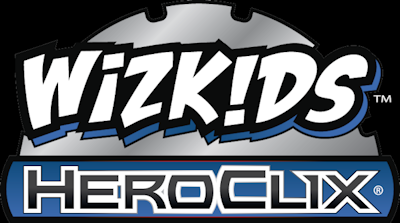 ... ...  or or 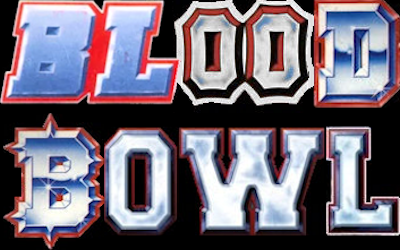 They can be for a GENERAL subject or character like  or or  They can be for a specific MATERIAL from which the die is made like  They can be for a SHAPE like  or or 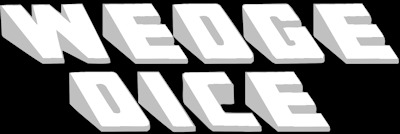 |
 SYMBOLS (Database symbol)  |
| <TEXT>
- Describes a visual aspect such as an image ... texture of a
die ... or shape EXAMPLE:  Is the description for these dice  EXAMPLE:  Is the description for these two dice |
 SYNONYMS FOR DICE  |
| Dice have been called by many names over the centuries ...
Bones ... Stone ... Math Rocks ... Click Clacks ... Chonk or Chonky Bois (large dice) ... Number Tumblers |
 TETRAHEDRAL FOUR-SIDED DICE CONFIGURATIONS  |
|
The tetrahedral four-sided die is by far the most common shape of
four-sided die but it is not the only shape ... I have found at least 37 shapes over the years. Four-sided dice are likely the oldest dice dating back to UR ... 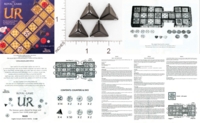 The die used in this game is technically 'Top Read' and ... predates the  but will not be considered as it was not mass-produced
but will not be considered as it was not mass-produced This section will discuss ... tetrahedral four-sided dice which are ... regular figures composed of four equilateral triangular-shaped faces ... This can include dice whose general shape are composed of four equilateral triangular areas such as Truncated Tetrahedrons or Concave Tetrahedrons Unlike the other platonic solid shaped dice ... they are not usually read by looking at the upward facing side of the die. 1) BASE READ First mass-produced by : Zazz Introduced : 1963 List of examples in the collection: LINK How to read: The resulting roll is determined by one of two methods: * Lift the die and examine the result that is facing the rolling surface * Examine the the three sides and determine the value which is NOT visible . EXAMPLE: NOTES: Cumbersome to read Resulting roll of example above is a 1 2) BOTTOM READ First mass-produced by : Likely  Introduced : mid 1970's Alternate Name: Old School ... Base Numbered or Blunts List of examples in the collection: LINK How to read: The resulting roll is determined by the result at the center of the bottom (edge closest to the rolling surface) of each face of the die EXAMPLE: NOTES: Most of these d4's are Truncated Tetrahedrons (a tetrahedron with the points cut off) This was the first type of mass-produced d4's and were first made by manufacturers such as: 3) TOP READ First mass-produced by :  Introduced : 1995 Alternate Names: CHESSEX Style ... Vertex Numbered ... On Points List of examples in the collection: LINK How to read: The resulting roll is determined by the result at the top vertex of each face of the die (point at the top of the die) EXAMPLE:  4) TIP-TOP READ First produced by : Possibly me (Kevin Cook) Introduced : June 2002 List of examples in the collection: LINK How to read: The resulting roll is determined by two methods: * The result at the top vertex of each face of the die (flat surface at the top of the die) * The result on the uppermost flat surface of the die EXAMPLE: NOTES: This type is another Truncated Tetrahedral d4 At the time I created this type I did not know of Joseph Fjelstad's die (see below) ... so ... I am not sure who first started numbering the 'TIPS' This type combines the features of "Top Read" and "Tip Read" (see below) 5) TIP-BOTTOM READ First produced by : Possibly me (Kevin Cook) Introduced : June 2002 List of examples in the collection: LINK How to read: The resulting roll is determined by two methods: * The result at the top vertex of each face of the die (flat surface at the top of the die) * The result at the center of the bottom (edge closest to the rolling surface) of each face of the die EXAMPLE: NOTES: This type combines the features of "Bottom Read" and "Tip Read" (see below) 6) BOTTOM-RIGHT READ First mass-produced by :  Introduced : 2005 List of examples in the collection: LINK How to read: The resulting roll is determined by the result at the right vertex of the bottom (edge closest to the rolling surface) of each face of the die EXAMPLE: NOTES: This set is called SOLAR This type of d4 has a unique feature of having the numbers on the bottom edge of each face like "Bottom Read" ... but on the right hand side of each edge 7) TIP READ First produced by : Joseph Fjelstad Introduced : 2006? List of examples in the collection: LINK How to read: The resulting roll is determined by the result at the top vertex of each face of the die (flat surface at the top of the die) EXAMPLE: NOTES: Another example of truncated tetrahedral d4 This type came to my attention and was added to the collection in 2006 ... I am unsure as to when it was invented This die is an exception to the above statement as the resulting roll is found on the upward facing side 8) THREE-SIDED BOTTOM READ First mass-produced by : Zombie Orphius Introduced : 2016 List of examples in the collection: LINK How to read: How to read: at the center of the bottom (edge closest to the rolling surface) of two or three visible faces of the die EXAMPLE: NOTES: Three of the sides sides are normal "Bottom Read" and the fourth side has been replaced by a symbol Resulting roll of example above are both 4 9) SINGLE-NUMBER TOP READ First mass-produced by : 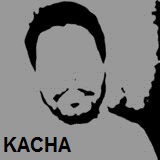 Introduced : 2017 List of examples in the collection: LINK How to read: The resulting roll is determined by the result at the top vertex of one face of the die (point at the top of the die) ... the other two faces are unmarked EXAMPLE: NOTES: Similar to "Top Read" but differs as there is only one number or symbol at the top of the face on one side of the die instead of three Resulting roll of example above is a 4 10) SINGLE-SIDED TOP READ First mass-produced by :  Introduced : 2020 List of examples in the collection: LINK How to read: The resulting roll is determined by the result at the top vertex of one face of the die (point at the top of the die) if visible otherwise the result is a four if three symbols are visible EXAMPLE: This first release is called: "Campfire" d4 ... It is an interesting type of d4 with symbols on three of the four sides ... with the fourth side having 1 .. 2 .. 3 Reading this type of die takes some practice as rolls often occur where only two of the four sides can be seen ... and if two symbols are seen ... the third observable (not the side touching the rolling surface) must be examined to determine the value of the roll If a third symbol is seen ... the value of the roll is a 4 ... otherwise the upward number (closest to the top vertex) is the value of the roll Resulting roll of example above is a 1. *** NOTE: Many thanks to Tina Manneborn ... David Caceres ... and Daniel Lawrence for their assistance with this section 11) INVERTED BASE READ First mass-produced by : 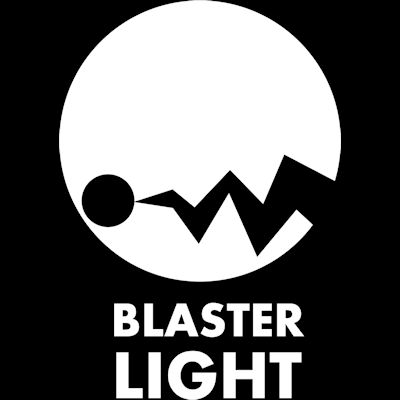 Introduced : 2024 List of examples in collection : LINK How to read: The resulting roll is determined by the upward facing value |
 TRUE D10 (Database Term)  |
| TRUE D10's are those dice that instead of
being numbered 0-9 .(as most D10's are) ... are numbered 1-10 An exception to this rule is a TRUE D10 which is numbered 1-10  |
 UNDERSCORE VS DOT  |
| Many dice have numbered indicia
and the orientation of the numbers can cause confusion as to the
result ... Examples: * 6 and 9 on a d11 or higher can cause confusion as 6 is an upside down 9 * 19 or 61 on a d70 or higher can cause confusion as 19 may be read as an upside down 61 D10's do not require ... but sometimes have ... an indicator for orientation as the trapezohedral faces indicate which is the proper orientation Denominations of numeric dice below a D9 do not require an indicator as they do not contain both a 6 and a 9 .. an exception to this rule are numbered D6's ... they often have either an underscore below or a dot to the right of the 6 ... although I do not understand why it would be needed As to other denominations of dice ... there are two methods for determining which side is the bottom of the number UNDERSCORING (or underlining) is one method used to show how to read a 6 or a 9 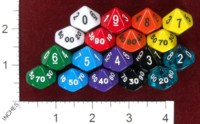  DOTS (or periods or full stops) are another method that can be used 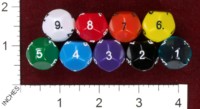 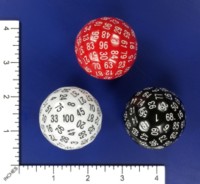
|
 WHAT ARE DICE?  |
| Dictionaries and encyclopedias seem to be behind the times
when it comes to the definition of dice |
 WHAT ARE INDICIA?  |
| INDICIA ...
as it pertains to dice ... is another term I learned while
preparing for the Michael Bowling (Crystal
Caste) v. Hasbro deposition Indicia is not often used in the database or website but I thought it should be included here An indicia is a mark on a die that shows a result of the die being rolled Here are some examples of forms of indicia :
The result of the roll is usually the topmost indicium (singular of indicia) on a face ... but not always ... as in 'old school' four-sided dice (d4) Notice how the number rolled is the bottommost number?  Another example where the number
is topmost ... but is on an edge ... not on a face ... is the
first image below
I came up with this design in 2003 and may have been the first to do so ... I call them Straight Edge dice ... after the Punk Subculture A couple of manufacturers have also used this idea ... but not on sharp edged dice ... second image | ||||||||||||||||||||
 WHAT ARE PERCENTILE DICE?  |
| Percentile or Percentile Dice ... are used for those gaming
systems that use percentages ... usually for skill or luck based
rolls This kind of roll generates a number from one (1) to one-hundred (100) ... hence the name Percentile I discuss the methods by which the number is generated HERE |
 WHAT ARE PIPS? (Database term)  |
| A pip ... when speaking of dice ... is technically a dot or circle ... but over the years has come to mean any type of indicia |
 WHAT ARE POLYHEDRAL SETS?  |
| Polylhedral dice can technically be
.... any shape that can have INDICIA applied such that a recognizable result is generated when rolled ... cast ... or spun For purposes of pen and paper gaming Polyhedrals ... Polyhedral Dice ... Polyhedral Sets... or even just Polys ... has come to mean a set of dice used for a game  Over the years Polyhedral Sets have contained differing number of dice 5-die sets were the first sets and were before the D10 was invented  6-die sets came next after the D10 but before the deckaider was invented  7-die sets came next and are the most popular type of set today 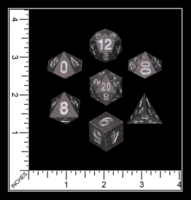 8-die sets are a 7-die set plus a D2 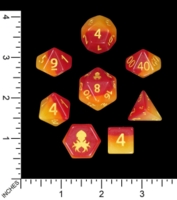 9-die sets are a 7-die set plus 2 D6's  10-die sets are a 7-die set plus 3 D6's for 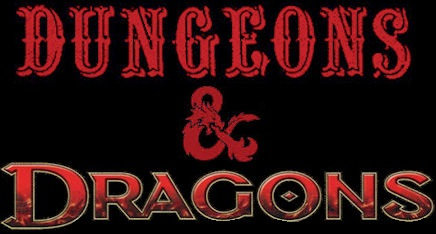 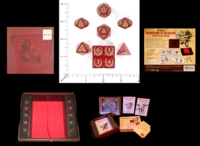 11-die sets are a 7 die set plus one D20 and 3 D6's 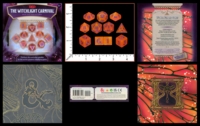 12-die sets are unique to  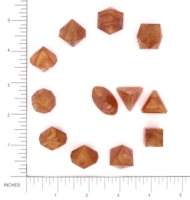 |
 WHAT ARE TEETOTUM?  |
Teetotum are a type of die that is ... generally ... spun (rather than cast or rolled) to produce a random outcome ... they CAN ... however... be rolled like any other kind of die The most common form of teetotum today is the   WHAT ARE THE LARGEST AND SMALLEST DICE?  In the 45+ years I have been collecting there have been several dice that stand above .... and ... below all others THESE or THESE seem to be the largest dice that I have ever seen ... they seem to be 10 feet or 120 inches (3.048 meters) high THESE seem to be the world's smallest dice ... 0.11811 inches (0.3mm) high So .. as both of these are D6's ... you can fit 1016 of the smallest across the face of the largest die ... and 1,048,772,096 inside the largest die On March 4 2008 Ernest Gary Gygax passed away ... At Gen Con 2008 ... THIS DIE (the largest d20 I have seen) was presented to the public to commemorate his contribution to gaming If you wish to see the largest and smallest dice that are in the collection ... Click below |
 WHAT IS A COMPLETIONIST?  |
 WHAT KINDS OF DICE ARE THERE?  |
| There really are far too many kinds of dice to discuss but I do discuss some of the most common ones HERE |
 WHAT TO DO IF A DIE IS HEAT DAMAGED?  |
| Plastic dice can become heat damaged for several
reasons ... Left on the radiator ... Fell into a coffee cup on a cup warmer ... Left in a heated ultrasonic cleaner too long ... Left for a long time in the sun ... etc When this happens ... the die usually turns white ... and no amount of soap and toothbrush seems to remove the damage Until recently I assumed that there was no way to recover this kind of damage. In 2024 I heat damaged the d30 and the d3 from Gorgon's Gaze set by leaving it too long in my ultrasonic cleaner 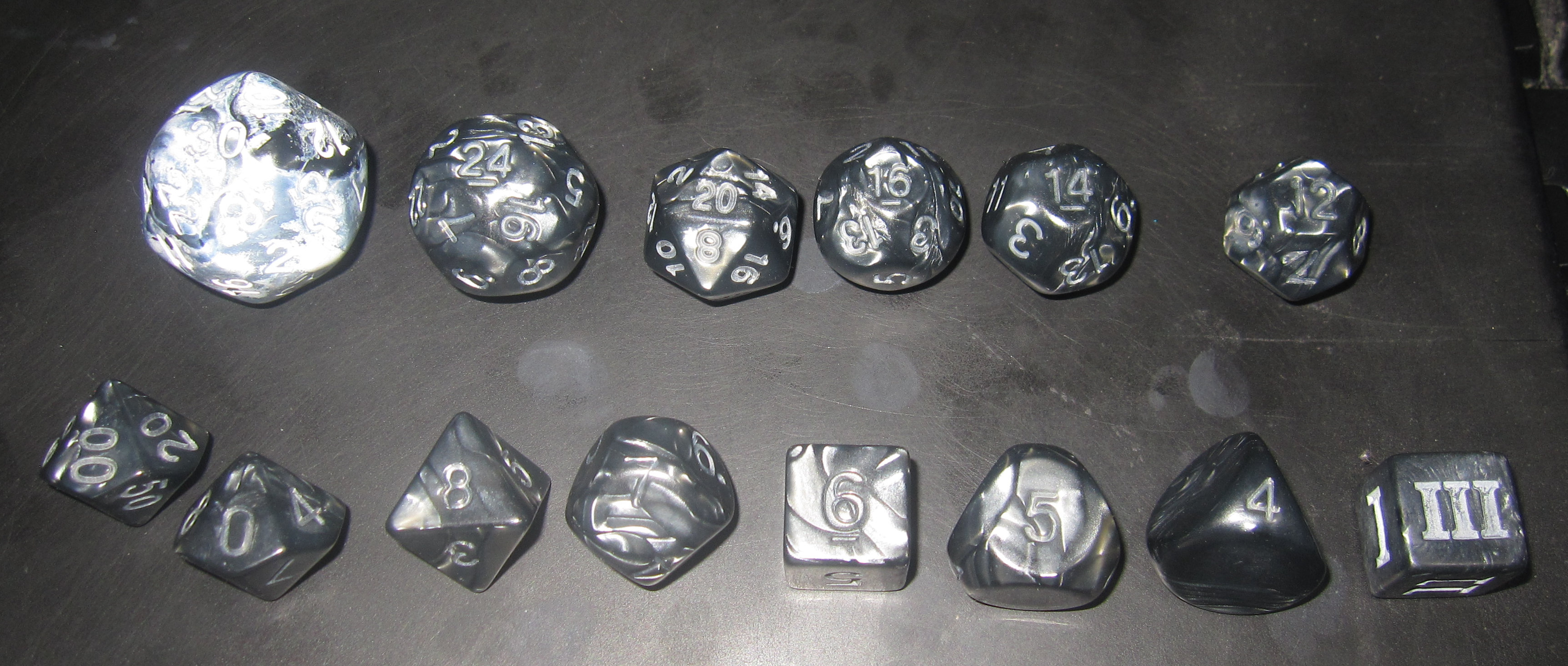 Using a rotary tool (Dremel) with a wool buffing/polishing wheel lubricated with jewelers rouge I was able to remove the heat damage and restore the original finish * Be careful with the amount of pressure applied as friction can abrade the surface of the die * Rouge will likely accumulate in the indicia and can be removed with soap and water + a very fine dremel bit ... You can skip removal if you plan to recolor the die with RED or a color darker than the rouge 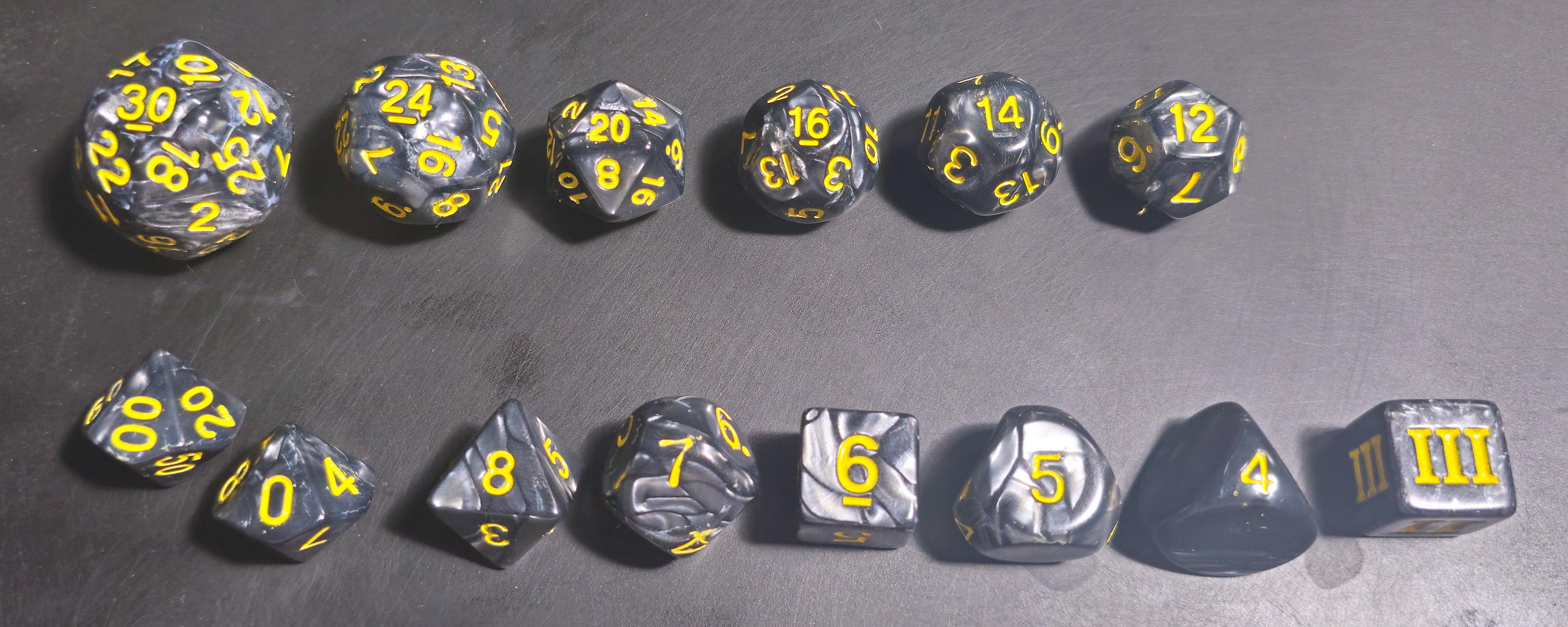 |
| When the Brand
Page was created most if not all of the dice company logos
were in Black and White ... See Early
Polyhedral
Dice for examples To try to not show preference to the later "colorful" logos ... I compromise and use greyscale so I can show the diverse contrast of newer logos but not minimize the older monotone logos |
 WHAT SHAPES DO DICE HAVE? (Dice Theme type & Special Page)  |
| There are many SHAPES
of dice ... Over 280 found to date and more being added regularly
For millennia dice took the shape of one of the Platonic Solids Here are some examples : * The four-sided (Tetrahedral) dice from the Royal game of UR  (Reproduction) (Reproduction)* The six-sided (Cubic) die from the Egyptian (Ptolemaic period)  (Reproduction) (Reproduction)* The twenty-sided (Icosahedral) die from the Romans 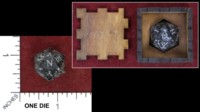 (Reproduction) (Reproduction)There were exceptions to this ... as you can see ... there are no eight-sided (Octahedral) or twelve-sided (Dodecahedral) dice from ancient times This is a Rhombic Dodecahedral twelve-sided die also from the Egyptian Ptolemaic period 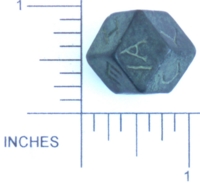 (Reproduction) (Reproduction) Other examples of  shapes shapes There is a theme page devoted to classes of  as well as a page devoted to the different shapes I have found so far  |

